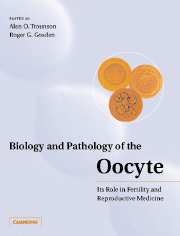Preface
Published online by Cambridge University Press: 05 August 2016
Summary
From the moment of discovery by von Baer in the 1830s, mammalian oocytes have fascinated biologists, yet it was only recently that they became objects of acute research activity, targets for biotechnology and topics of public interest. In vitro fertilization (IVF) and cloning have revolutionized our view of this most rare cell.
The oocyte is often said to be a unique cell, but this overused expression is rather empty. Every cell type has a phenotype of its own, but only this cell can serve in the female body as a genetic hinge connecting the doors of successive generations. In this connection, oocytes are the only cells in the body that undergo meiosis and fertilization. What is more, even in the era of reproductive cloning, they are still needed for reproduction and genetic survival of the species, even if they are unnecessary for the actual survival of the individual. They are paradoxical cells, being at the same time both highly specialized for their role and totipotent, so that every other cell type in body can be generated.
Given their remarkable biology and high socioeconomic value, amounting to a thousand dollars or more per cell in egg donor programmes in the USA, it is surprising that oocytes have rarely been given the tribute of a specialized book. Several years ago, Cambridge University Press devoted an entire volume in the series of Cambridge Reviews of Human Reproduction to ‘The Female Gamete’. There has not been a successor volume - until now.
We are privileged to be the editors of a volume of chapters on the biology and technology of oocytes authored by some of the foremost scientists currently working in the field. We aimed to encompass topics that are key to human reproductive biology and medicine as well as animal breeding technology and cloning. After a historical prologue by Roger Short, the first section focuses on the life cycle of oocytes, and chapters focus on origins, follicle development and dynamics from birth to menopause. The second, and largest, section considers the molecular development and pathology of oocytes. It covers the mechanisms of meiosis and accumulation of molecules and organelles, which are essential for the production of a fertile gamete and which are the foundations for understanding the causes of ageing, aneuploidy and ovarian failure in later chapters.
- Type
- Chapter
- Information
- Biology and Pathology of the OocyteIts Role in Fertility and Reproductive Medicine, pp. xi - xiiPublisher: Cambridge University PressPrint publication year: 2003



